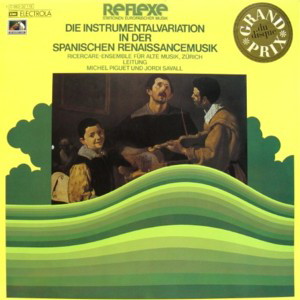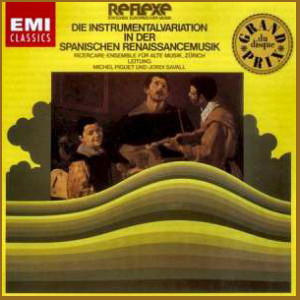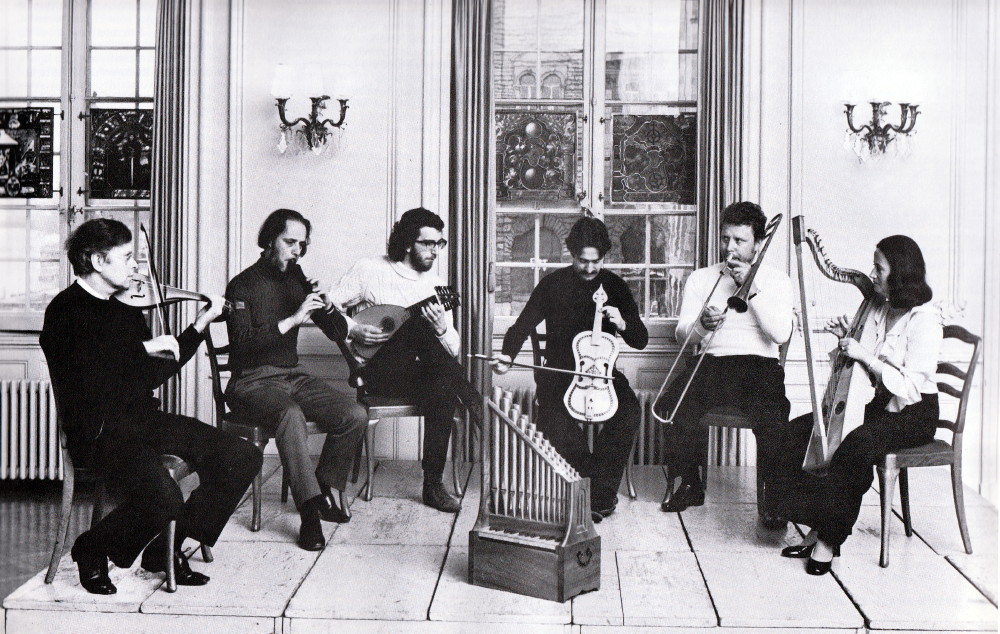 |
1 LP -
1C 063-30 116 - (p) 1973
|

|
| 1 CD - 8
26484 2 - (c) 2000 |
|
| DIE INSTRUMENTALVARIATION IN
DER SPANISCHEN RENAISSANCEMUSIK |
|
|
|
|
|
| I.
VARIATIONEN ÜBER EINE MELODIE |
|
|
- Viva la
Margarita (Enríquez de
Valderrábano, 16. Jhdt.) - Schalmei,
Alt-Pommer, Posaune
|
1' 58" |
|
| - Diferencias
sobre el "Canto del Cavallero"
(Antonio de Cabezon, 1500-1566) - Spinett |
2' 50" |
|
| - Cinco
diferencias sobre Conde Claros
(anonym) - Baß-Blockflöte,
Laute, Gambe |
1' 39" |
|
| - Diferencias
sobre el canto de "La Dama la
demanda" (Antonio de Cabezon,
1500-1566) - Orgel |
3' 09" |
|
| II. TÄNZE MIT VARIATIONEN |
|
|
| - Discante sobre
la Pavana Italiana (Antonio de
Cabezon, 1500-1566) - Tenor-Blockflöte,
Laute, Gambe |
2' 39" |
|
| - Para quien
crié yo cabellos (folia)
(Antonio de Cabezon, 1500-1566) - Spinett |
2' 05" |
|
| - Diferencias
sobre la Gallarda Milanesa
(Antonio de Cabezon, 1500-1566) - Sopran-Blockflöte,
Spinett, Gambe |
2' 31" |
|
| - Cuatro
diferencias sobre "Guárdame las
vacas" (Luys de Narváez
(Narbais), 16. Jhdt.) - Laute |
1' 20" |
|
| - Cinco
diferencias sobre Las Vacas
(anonym) - Alt-Blockflöte, Viola
da braccio, Gambe, Baß-Dulzian,
Spinett |
1' 39" |
|
| III. INSTRUMENTAL STÜCKE AUS
"LAS ENSALADAS" |
|
|
| - La Justa
(Mateo Flecha el viejo, 1481-1553) -
Sopran-Blockflöte, Alt-Dulzian,
Viola da braccio, Gambe |
3' 46" |
|
| - La Guerra
(Mateo Flecha el viejo, 1481-1553) -
Schalmei, Pommer, Posaune,
Baß-Dulzian, Spinett, Schlagzeug |
1' 34" |
|
|
|
|
| IV. "RECERCADAS" ÜBER
ITALIENISCHE "TENORES" |
|
|
| - Romanesca (Diego Ortiz, 1525-?) - Gambe,
Spinett |
1' 16" |
|
| - Ruggiero (Diego Ortiz, 1525-?) - Gambe,
Laute |
1' 30" |
|
| - Passamezzo moderno (Diego Ortiz, 1525-?) - Gambe,
Laute |
3' 01" |
|
| V. VARIATIONEN ÜBER "CANTUS
PLANUS" |
|
|
| - Danza alta (Francisco de la Torre) - Schalmei,
Posaune,
Schlagzeig |
0' 55" |
|
| - Recercada II sobre canto Ilano (Diego Ortiz, 1525-?) - Gambe,
Spinett,
Baß-Dulzian |
1' 36" |
|
| - Recercada IV sobre canto Ilano (Diego Ortiz, 1525-?) - Gambe,
Spinett,
Baß-Dulzian |
2' 38" |
|
| - Tres sobre el Canto Ilano (Diego Ortiz, 1525-?) - Alt-Blockflöte,
Alt-Dulzian,
Laute, Gambe |
1' 30" |
|
| - Himno XI sobre "Ave maria stella VIII (Antonio de
Cabezon,
1500-1566 - Orgel |
1' 57" |
|
| VI. VERZIERTE CHANSONS |
|
|
| - Mille regrets (Josquin
des Préz)
(Luys de
Narváez
(Narbais),
16Jhdt.) - Laute |
2' 29" |
|
| - Doulce Mémoire (Pierre
Sandrin) (Diego Ortiz, 1525-?) - Gambe,
Laute |
1' 20" |
|
| - O felici occhi miei (Jacques
Arcadelt) Diego Ortiz, 1525-?) - Tenor-Blockflöte,
Laute, Gambe |
1' 53" |
|
|
-
D' Ou vient
cela (Antonio
de Cabezon,
1500-1566) - Orgel |
3' 31" |
|
|
|
|
| RICERCARE -
Ensemble für alte Musik, Zürich / Michel
Piguet und Jordi Savall, Leitung |
|
| -
Michel Piguet, Schalmei,
Blockflöten |
|
| -
Richard Erig, Alt-Pommer |
|
| -
Christopher Schmidt, Viola da
braccio |
|
| -
Jordi Savall, Gambe, Schlagzeug |
|
| -
Walter Stiftner, Alt- und
Baß-Dulzian |
|
| -
Heinrich Huber, Posaune,
(engmensuriert) |
|
| -
Anthony Bailes, Laute |
|
| -
Anne Gallet, Spinett |
|
| -
Bernhard Billeter, an der
historischen Orgel im Kloster Muri,
Schweiz |
|
|
|
|
|
Luogo
e data di registrazione |
|
Kirche
Neumünster, Zürich (Svizzera) -
ottobre 1972 |
|
|
Registrazione: live /
studio |
|
studio |
|
|
Producer / Engineer |
|
Gerd
Berg / Johann-Nikolaus Matthes
|
|
|
Prima Edizione LP |
|
EMI
Electrola "Reflexe" - 1C 063-30
116 - (1 lp) - durata 47' 33" -
(p) 1973 - Analogico |
|
|
Prima Edizione CD |
|
EMI
"Classics" - 8 26484 2 - (1 cd) -
durata 47' 33" - (c) 2000 - ADD |
|
|
Note |
|
- |
|
|
|
|
|
 THE
INSTRUMENTAL VARIATION OF
SPANISH RENAISSANCE MUSIC THE
INSTRUMENTAL VARIATION OF
SPANISH RENAISSANCE MUSIC
A. Cultural Influences on
the ,,Siglo de Oro“
The cultural influences
determining the development of
Spanish music through the
changing periods of its
history to the extreme
richness of the ,,Siglo de
Oro“ go very far back and were
highly diverse. All of the
cultures that made themselves
felt in Spain for centuries -
the Greek, Roman and West
Gothic traditions, the Jews
who had been in Spain since
early antiquity and, of
course, the Arabs (eighth to
eleventh centuries) who had
swept up nearly the entire
peninsula - have left their
traces in full breadth and
variety. Their influence on
the instruments, dances and
tunes of folk music was
particularly strong. Artistic
exchange with France, Germany
and England in the twelfth,
thirteenth and fourteenth
centuries proved also
fruitful. These many
influences formed the fultural
soil in which Spanish music
could develop to full maturity
during the reign of the
Catholic kings and of Charles
V and Philip II
(1474- 1598).
This epoch is especially
interesting, in terms of both
the quality as well as the
originality of the repertory
that has come down to us. It
is the time when the borders
were finally opened for
Spanish artists and composers,
as is confirmed by the
international fame that many
Spanish musicians acquired
even during their own
liftetime: Francisco Guerrero,
Cristóbal
Morales and Tomas de Victoria,
for example, as composers of
sacred music and Antonio de
Cabezón,
Mateo Flecha,
Diego Ortiz and Juan Vasquez
for their secular music.
The magnificent development of
the repertory for keyboard,
harp, vihuela de mano (Spanish
lute), vihuela de arco (gamba)
and- other instruments - which
included development of the
variation (also called
“diferencia”, “discante”,
“recercada” or “glosa”) - is
one of the main aspects of
Spain’s contribution to
European music of the
Renaissance.
The instrumental literature
that has been preserved has
significance even if it is not
very comprehensive due to
reasons like the false egoism
of which Bermudo speaks in his
“Declaracion de instrumentos
musicales” and which caused
several composers to retain
their best works for
themselves. Moreover,
propagation was difficult as
printers in Spain were rare,
and then, too, many
manuscripts were destroyed in
fire and war. Among the
composers, the most striking
personalities were Antonio de
Cabezón,
Francisco Pérez
Palero, Francisco de Soto,
Diego del Castillo, Pedro Vila
(for keyboard instruments),
Luys Milán,
Luys de Narváez,
Enríquez
de Valderrábano,
Alonso Mudarra, Miguel de
Fuenllana (for vihuela de
mano) and Diego Ortiz (for
vihuela de arco). All have
left works to us that excel in
beauty and profound ideas and
that are admired for the
lightness of skillful
inventiveness.
B. The Instrumental
Variation
When we consider the long and
intensive tradition of
instrumental music-making on
the peninsula, it is not
surprising that sixteenth
century Spain brought forth
instrumental music of high
quality, for its music could
call upon an abundance of
“romances”, “cantigas”,
folksongs and even sacred
vocal music. Quite surely
there had long been the custom
of playing many vocal pieces
on instruments (particularly
on plucking and keyboard
instruments). Certain forms of
instrumental music were
developed out of the
accompaniment of dances and
songs, which might be
considered the forerunners of
the variation or, to use the
Spanish word, “diferencia".
This basically improvized
method became popular during
the fifteenth and early
sixteenth centuries, after
which time it became a
standard procedure that was to
serve as a pattern to
innumerable musicians of
future generations.
The basis of each variation
was always the “glosa", a kind
of melismatic ornamentation.
The “glosa” might have
developed as follows:
1. in the
form of ornamented variations
on a melody
2. in the
form of contrapuntal
variations on a principal
voice (cantus firmus)
3. in the
form of melodic or harmonic
variations on a polyphonic
composition.
All of these various
procedures might have been
mixed in any combination, so
that a Renaissance composer
had practically an unlimited
number of artistic
possibilities at his disposal.
Our most important sources are
the publications of vihuelists
like Luys de Narváez,
Mudarra, Valderrabano and
Pisador; harpsichordists or
organists
like Antonio de Cabezón;
works found in the
collection of music for
keyboard instruments, harp
harp and vihuela of Venegas de
Henestrosa; and also the essay
on the "glosa" by the
violinist Diego Ortiz.
Attention must
be called to the following
forms:
- “Diferencias”
on a theme or melody which were
then sometimes already known as
“romances viejos”. Themelody
appears as discant or as
cantusfirmus.
- Dances
with variations -
The “pavana", the
“gallard", the “folia”,
etc., are used as
the basis for the
development of
variations, especially
in the outer voices (discant
and bass).
- Works
with a descriptive
character, like
“Tientos de Batalla" and
“Ensaladas”, in
which programmatic ideas
areexpressed.
- Variations
on ostinato basses
(the Italien
“tenores”). In
general they take their
starting point from
dances like the
“romanesca”, the“passamezzo”,
the “folia", etc.,
which,basically
unchanged, become the
“bassoostinato"
or ground bass of the
variation.
- Variations
on a cantus planus
(cantus
firmus).The basic
element consists of a
liturgicalor secular
tune which appears in
the form of a
“cantus planus” or
plainsong (i.e., inlong note
values) while, as a
rule, the
variations are developed
in a contrapuntal style (“contrapunto
concertante”).
- Ornamented
chansons (“g|osas”
onvillancicos,
chansons, etc.), i. e.,
works that
reveal the direct
influence of the art of
improvized decoration,
especially in connection
with instrumental
settings of vocal
works, in which at least
one (and often
several) sections of the
work are ornamented.
The- style is determined
by the
technical possibilities
of the instrument
(vihuela, viola da
gamba, harpsichord,
organ) for which the
arrangement was
made.
- Preambles
or variations on
“fabordones” or
liturgical themes
(derived from Gregorian
psalmodies) that were
played chiefly
during worship services.
C. The
“Ministriles” and Their
Instruments during the
Spanish Renaissance
The “ministriles” were
musicians who, at least from
the fifteenth century on,
had to provide the “musica
da camara" at court and
bourgeois festivities. On
August 24, 1420, Alfonso el
Magnánimo
wrote his organ-builder in
Valencia a letter in which
he gave him the following
advice: “Prengats càrrec
de obrar los dits òrguens
petits, que sien intonats ab
los ministrés” (Take care
that the little organs are
tuned according to the
instrumentalists). The
“ministriles” also took part
in performances of sacred
polyphonic works until 1572,
when Philip II,
for unknown reasons, forbade
them to enter his chapel.
According to a document of
1572, it had been ordered
“que no sirban en la capilla
como lo solian hazer”,
that is, they were no longer
to play in the chapel they
had been previously wont to
do.
The documents preserved in
the archive of Simancas do
not state the exact kinds of
instruments played by the
musicians who belonged to
the “Ministri|es de la Casa
Real” (Minstrels of the
Royal House). There is
simply mention of a
“menstril de flauta", “de
vihuela de arco” or “musicos
de tecla”. On the other hand
an inventory list of Queen
Mary of Hungary (the sister
of Charles V, who died in
Spain on October 28, 1558)
affords us an idea of the
great variety of instruments
used by the “ministriles”.
The following instruments
are among those found on the
list:
5
violones de arco, que llaman
de braço
(viols, also called “de braço" -
arm viols)
14
vihuelas de arco, grandes y
pequeñas
(gambas, large and small)
6
vihuelas de arco, hechase en
Alemania (gambas built in
Germany)
8
sacabuches (trombones)
6 pifanos
de farfil (ivory fifes)
15
pifanos (files)
15
pifanos (fifes)
1 corneta de
marfil (ivory cornetto)
14
cornetas negras (black
cornettos)
16
cornetas de Alemania (from
Germany)
6
cornetas de madera (wooden
cornettos)
8
cornetas acordadas con las
chirimias (cornettos tuned
to the shawms)
4 regalas
a manera de chirimias
(shawm-sounding regals)
2 contrabajos
grandes de chirimia (bass
shawms)
1
chirimia grande (large
shawm)
5
chirimias mas pequeñas
(smaller shawms)
2 chirimias pequeñas
(small shawms)
2
chirimias tiples (discant
or soprano shawms)
19
flautas grandes y pequeñas
(large and small
recorders)
7
flautas de Alemania
(transverse flutes)
9 orlos
de Alemania (cromornes -
crummhornes)
1 fagot
contralto (alto bassoon)
2
fagotes contrabajos (bass
bassoons)
1 dulçaina
(dolcian or cromorne)
3
clavicordios or
monicordios (harpsichords
or spinets)
4 laudes
(lutes)
Despite the use of all
these instruments, after
1538 only the works
printed for vihuela de
mano, vihuela de arco and
key board instruments have
been preserved.
Nonetheless, the fact that
“músicos
tañedores
de tecla” (keyboard
artists) like Francisco de
Soto or Antonio de Cabezón
performed in the small
instrumental ensemble of
the “ministriles” proves
that the ensemble’s
repertory was easily
combined with the organ or
harpsichord and thus could
not have been very
different.
This assumption is
confirmed for us by
Hernando de Cabezón
who wrote in the foreword
to the “Obras de música
para tecla, arpa o
vihuela” of A. de Cabezón
that also the
“ministriles” could profit
from the book as they
would find diminutions in
it on the compositions and
would be able to see how
each voice can have its
freedom without
encroaching upon the other
parts. This would appear
in many motets, chansons
and fauxbourdons, and,
with a little effort, the
could derive their voices
from the tablature
presented.
All of our historical
sources verify that the
repertory of the
“ministriles” consisted of
polyphonic (tientos,
madrigaIes, chansons) and
homophonic works
(fauxbourdons, ostinato
basses. dances) on which
there were improvisations in
“glosas” or “diferencias”.
That is why the variation
that has com down to us in
versions for keyboard
instruments, vihuela de mano
or vihuela de arco is an
invaluable aid in appraising
the improvising skill of
Spanish “ministriles” in the
sixteenth century.
(Translation:
E. P.
Echols)
|
|
|
EMI Electrola
"Reflexe"
|
|
|
|

